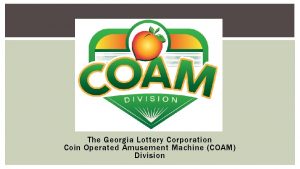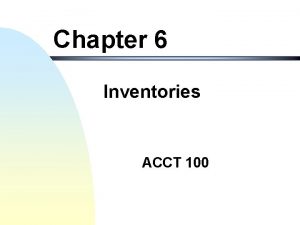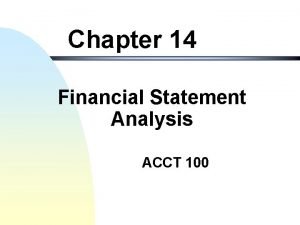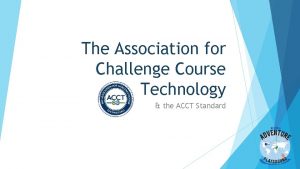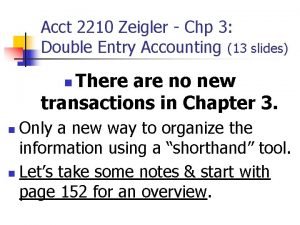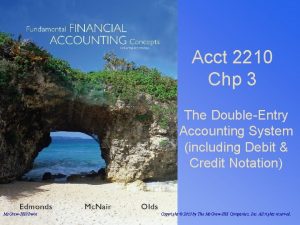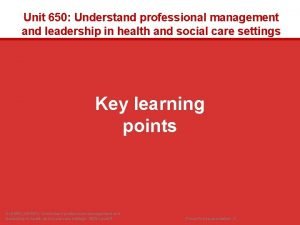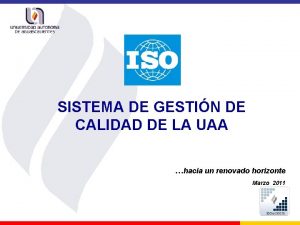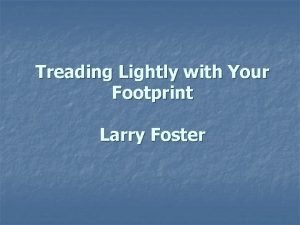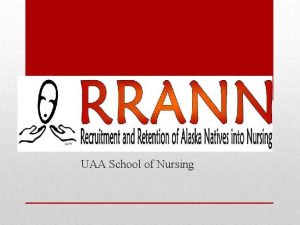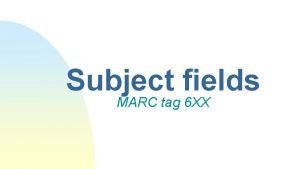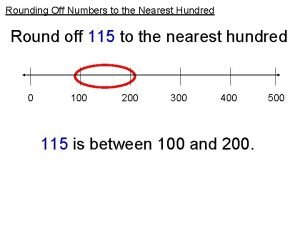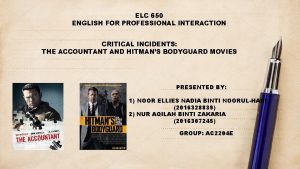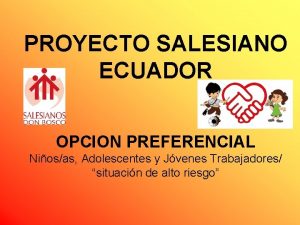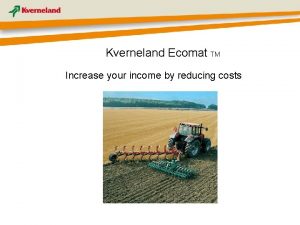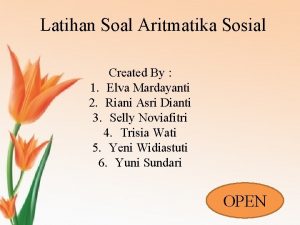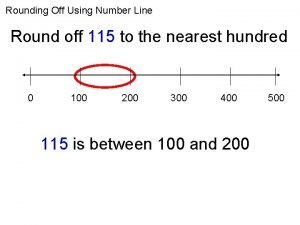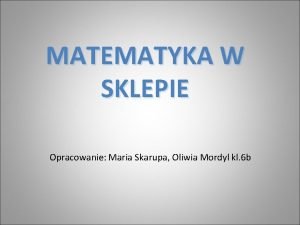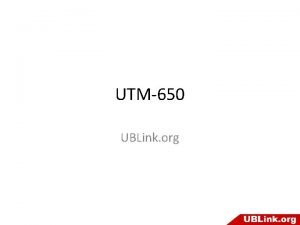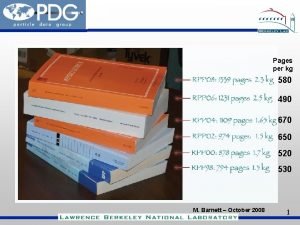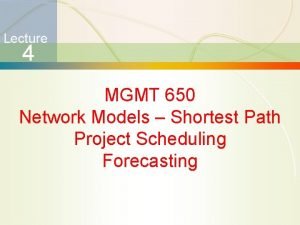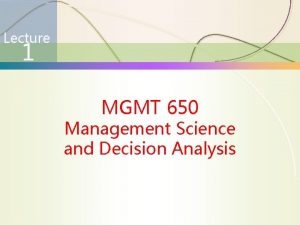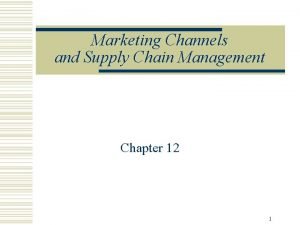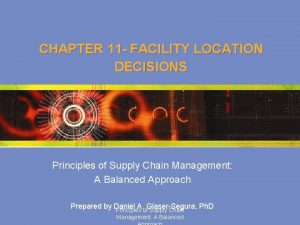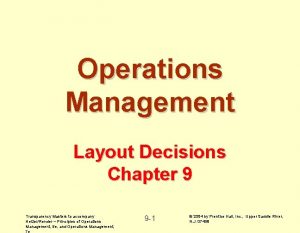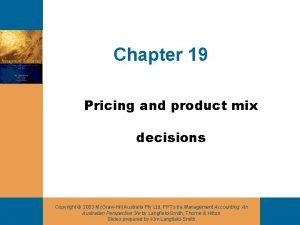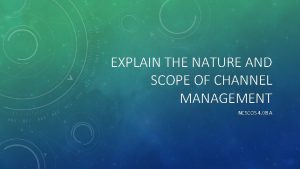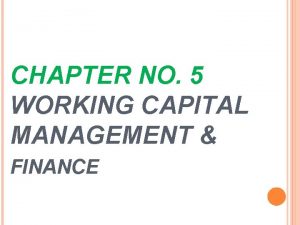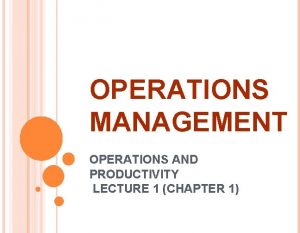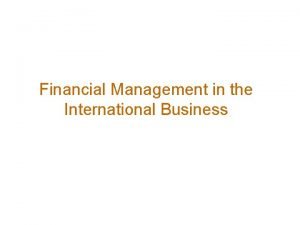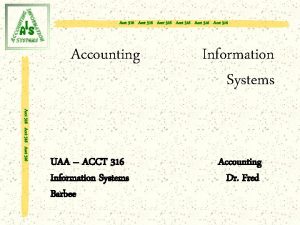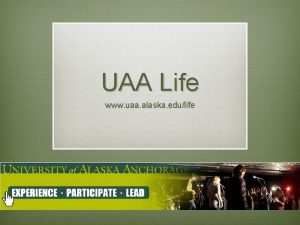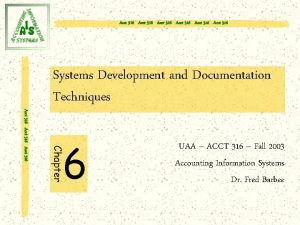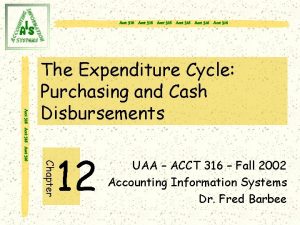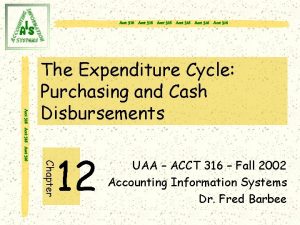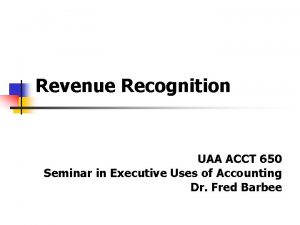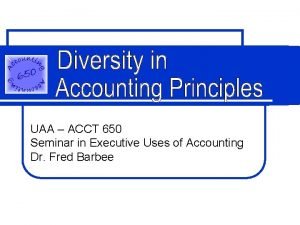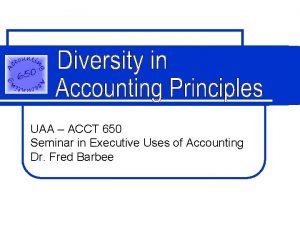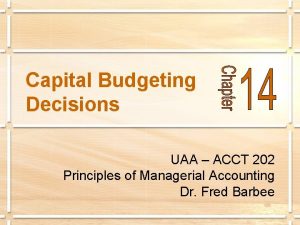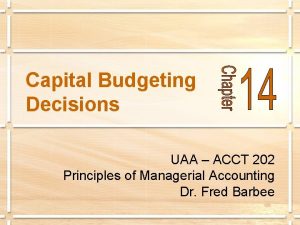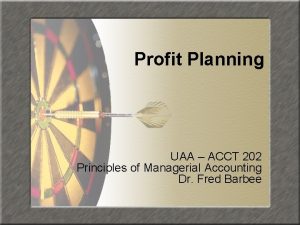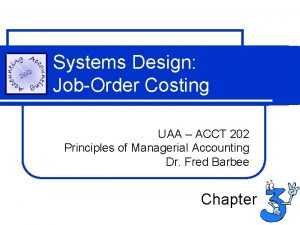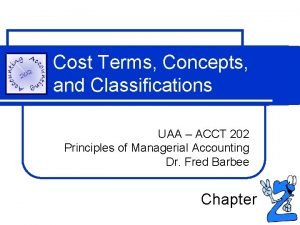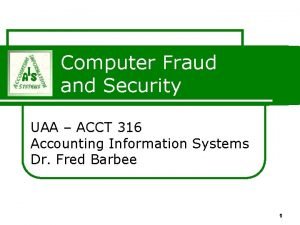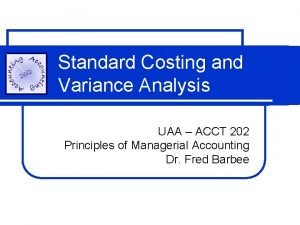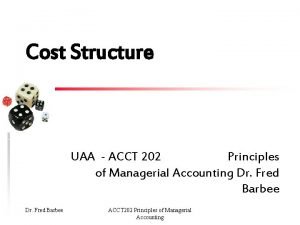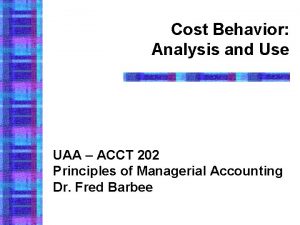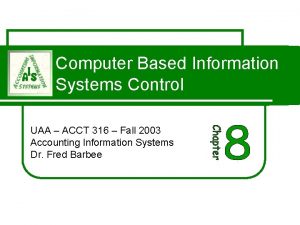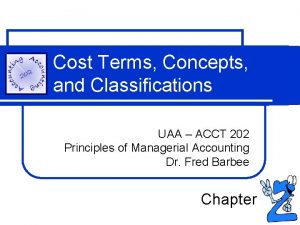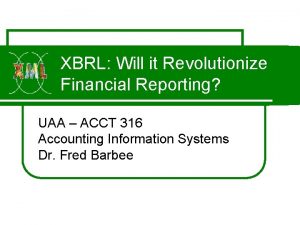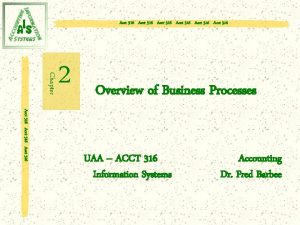Understanding Costs For Management Decisions UAA ACCT 650




























































































- Slides: 92

Understanding Costs For Management Decisions UAA – ACCT 650 Seminar in Executive Uses of Accounting Dr. Fred Barbee

“We made too many wrong mistakes. ” “It ain’t over till its over!” “When you come to a fork in the road, take it!”

Section Four: Cost Concepts and Analysis Switching Gears


A Potpourri of Management Accounting Topics Let’s see what’s in the managerial accounting bag! Mgmt. Acct.

Managerial Accounting Vs. Financial Accounting WOW! A Comparison ! Mgmt. Acct.

External Uses Financial Reporting (Bank Loans) Financial Reporting (Owners/Investor s) Financial Reporting (Taxation) Accounting System Determine Cost Per Unit Performance Evaluation Internal Uses Non-Routine Decisions

Financial Accounting • External Focus • Follows externally imposed rules (GAAP) • Objective financial information • Historical orientation • Information about the firm as a whole (highly summarized)

Financial Accounting Information Systems Economic Events Collecting Measuring Storing Analyzing Reporting Managing Balance Sheet Income Statement of OE Statement of Cash Flows Inputs Processes Outputs Users

Managerial Accounting • Internal Focus • No mandatory rules • Both financial and nonfinancial information utilized; subjective information possible • Emphasis on future (heavy use of historical data)

Management Accounting Information Systems Economic Events Fin. Acct. Info. Non-Fin. Info Subjective Info. Collecting Measuring Storing Analyzing Reporting Managing Special Reports Product Costs Customer Costs Budgets Performance Reports Input Process Output Users

Management Accounting • Provides information to management for. . . – Costing product/service – Performance evaluations – Various non-routine decisions

Management Cost Accounting in a Manufacturing Firm Yes! A General Model of Cost Flow and Accumulation! Mgmt. Acct.

Cost Flows in a Manufacturing Firm Direct Materials Direct Labor Mfg. Overhead Work-in. Process Finished Goods Cost-of Goods Sold

Cost Flows in a Manufacturing. Costs Firm Manufacturing Direct Materials Direct Labor Mfg. Overhead Costs incurred in the manufacture of goods being produced. Work-in. Process Finished Goods Cost-of Goods Sold • Known as product (inventoriable) costs. • They are expensed when the product is sold.

®Those that become Cost Flows in a materials Manufacturing Firman Direct Materials Direct Labor Mfg. Overhead integral part of the finished product and can be physically traced to the product. ®Those factory labor costs that can be physically traced to. Cost-of the Work-in. Finished Process Goods Sold production of. Goods the finished product. ®All costs associated with the manufacture of a product except direct materials and direct labor.

Direct Materials • Known as Direct costs. Period Labor Work-in. Process Nonmanufacturing Costs Cost-of Finished Goods Sold Costs incurred for • They are Mfg. other than production expensed in Overhead old S activities. the period in which they. Sales are Cost of Goods Sold incurred. Income = Gross Margin Statement = Nonmanufacturing Expenses Net Income

®Direct General Materials & Administrative Expenses All executive, organizational, and clerical costs associated with the general Direct Work-in. Finished management Cost-of Labor Goods Sold of the firm. Process ®Mfg. Selling Overhead & Distribution Expenses ld o S customer All costs necessary to secure orders and get the. Sales products/services to the customer. Income Statement = = Cost of Goods Sold Gross Margin Nonmanufacturing Expenses Net Income

Direct Labor Mfg. Overhead Product Costs Direct Materials Work-in. Process Finished Goods Cost-of Goods Sold Sales Income Statement = = Cost of Goods Sold Gross Margin Nonmanufacturing Expenses Net Income Period Costs

Some Other Definitions! Oh good! I love definitions! Mgmt. Acct.

Anything for which a separate measurement of Direct costs is desired (products, Costs customers, departments, etc. ) Indirect Costs Cost Object

Direct Costs that are related to and directly traceable to the identified cost objective. (Direct Material, Direct Labor) Cost Object Indirect Costs that are related to, but not traceable to, the identified cost objective. (Manufacturing overhead)

Cost is defined as. . . the value of assets given up, or to be given up, to acquire other assets.

Cost is defined as. . . the cash or cash equivalent value sacrificed for goods and services that are expected to bring a current or future benefit to the organization.

Cost is defined as. . . the cash or cash equivalent value sacrificed for goods and services that are expected to bring a current or future benefit to the organization.

Expense. . . • The value of assets given up to generate revenue. • An expired cost.

Cost Vs. Expense Theoretically, all costs become assets. Benefits Multiple Periods Unused Portion Used Portion Benefits Current Period Only But often are charged to expense immediately.

For Managerial Accounting: v. A cost can be classified in many different ways. v. An adjective is used to describe costs (i. e. , to signify their purpose).

Opportunity Cost • The benefit given up or sacrificed when one alternative is chosen over. Another.

Other Adjectives. . . v. Manufacturing/ Nonmanufacturing Costs v. Period/Product Costs v. Fixed/Variable Costs

Other Adjectives. . . v. Selling/Administrative Costs v. Differential Cost v. Sunk Cost

Relevant Costs • Any cost that is a future cost • Any cost that differs among alternatives and will influence the outcome, • Any cost that is avoidable

Avoidable Cost • A cost that can be eliminated (in whole, or in part) as a result of choosing one alternative over another.

Sunk Costs. . . • Costs that have been incurred or committed in the past. • Sunk costs are irrelevant because the decision maker no longer has discretion over them.

Issues in Managerial Accounting Yeah! A look at managerial accounting issues! Mgmt. Acct.

Cost Measurement Cost Accumulation Cost Assignment Direct Materials Direct Labor Mfg. Overhead Work-in. Process Finished Goods Cost-of Goods Sold Goal: Accurately costed products.

Cost Measurement Mgmt. Acct.

Actual Costing System Normal Costing System Standard Costing System Measuring Costs

Actual Costing System Costs charged to production: 1. Actual Direct Materials Normal Costing System Standard Costing System 2. Actual Direct Labor Measuring Costs 3. Actual Manufacturing Overhead

Direct Labor Mfg. Overhead Product Costs Direct Materials Goal: Accurately costed products Work-in. Process Finished Goods Cost-of Goods Sold Timeliness is critical Cost of Goods Sold - Sales Income Statement = = Gross Margin Nonmanufacturing Expenses Net Income Period Costs

Actual Costing System Normal Costing System Standard Costing System Costs charged to production: Measuring 1. Actual Direct Materials Costs 2. Actual Direct Labor 3. Estimated Manufacturing. Let’s Overhead look at

Predetermined Overhead Rate (POR) Estimated Overhead Budgeted Overhead POR = -------------------Budgeted Activity Usage Estimated Activity

Direct Labor Mfg. Overhead Product Costs Direct Materials Goal: Accurately costed products Work-in. Process Finished Goods Cost-of Goods Sold Timeliness is critical Cost of Goods Sold - Sales Income Statement = = Gross Margin Nonmanufacturing Expenses Net Income Period Costs

Actual Costing System Normal Costing System Costs charged to production: Measuring Costs 1. Standard Direct Materials Standard Costing System 2. Standard Direct Labor 3. Standard Manufacturing Overhead

Direct Labor Mfg. Overhead Product Costs Direct Materials Goal: Accurately costed products Work-in. Process Finished Goods Cost-of Goods Sold Timeliness is critical Cost of Goods Sold - Sales Income Statement = = Gross Margin Nonmanufacturing Expenses Net Income Period Costs

Variance Analysis: General Description Actual Quantity of Input at Actual Price AQ x AP Actual Quantity of Input at Standard Price AQ x SP Price Variance AQ x (AP - SP) Standard Quantity of Input at Standard Price SQ x SP Usage Variance SP x (AQ - SQ) Budget Variance (AQ x AP) - (SQ x SP)

Cost Accumulation Mgmt. Acct.

Cost Accounting Systems Product Costs Job-Order Costing Process Costing Total/Unit Cost

Process Costing. . . • Homogeneous products continuously produced. • Costs accumulated by process (time). • Unit cost = total cost for period divided by number of units produced.

Cost Flows in a Manufacturing Firm Direct Materials Direct Labor Mfg. Overhead Work-in. Process Finished Goods Cost-of Goods Sold

Process Costing System Process A DM DL MOH Process B Process C Finished Goods Cost of Goods Sold

Job-Order Costing. . . • Wide variety of distinct products. • Costs accumulated by job. • Unit cost = total cost of job divided by number of units produced.

Job-Order Costing Job 100 DM DL MOH Job 101 Finished Goods Cost of Goods Sold Job 102 Work in Process Finished Goods Cost of Goods Sold

Cost Assignment Mgmt. Acct.

Assigning Manufacturing Costs Functional Based Costing Activity Based Costing

Good! Cost Behavior! Mgmt. Acct.

Cost Behavior • Variable Costs • Fixed Costs • Mixed Costs

Variable Costs

Variable Costs • Total costs that vary in direct proportion to changes in the level of activity within the relevant range.

Total Variable Costs $ Volume (Activity Base)

Per Unit Variable Cost $ Volume (Activity Base)

Step-Variable Costs

Step Variable Costs Step Costs are constant within a range of activity $ But different between ranges of activity Volume (Activity Base)

Fixed Costs

Fixed Costs • Costs that remain constant in total, regardless of the changes in activity within the relevant range.

Total Fixed Costs $ Volume (Activity Base)

Per Unit Fixed Costs $ Volume (Activity Base)

Relevant Range

Curvilinear Costs and the Relevant Range Economist’s Curvilinear Cost Function $ Accountant’s Straight-Line Approximation Relevant Range Volume (Activity Base)

Mixed Costs

Mixed Costs $ Variable costs Fixed costs Volume (Activity Base)

Cost-Volume-Profit Analysis! That’s my very favorite! Mgmt. Acct.

Cost-Volume-Profit (CVP) • CVP is the systematic examination of the relationships among. . . – Selling prices, – Volume of Sales and Production – Cost, – Expenses, and – Profits

Total Revenues Total Cost Graphically As changes What happens occur here? Output Sales Price Total Revenues Total Cost Variable Costs Operating Income Fixed Costs Operating Income 4

Traditional Income Statement

Traditional Income Statement • Costs are grouped by functional classifications - such as: – Production, – Marketing, and – Administration • With both fixed and variable costs being included in each category.

Sales COGS Gross Margin $xxx Production (xx) FC & VC $xxx Selling Exp. Selling (xx) FC & VC Admin. Exp (xx) Net Income Administrative FC & VC $xxx

The Contribution Format Income Statement

The Contribution Margin • The focus of the contribution format income statement is the contribution margin. . . Contribution Margin = Net Sales - Variable Costs

Contribution Format I/S • Groups costs by behavior: – Fixed, and – Variable • Rather than into the functional categories of production, marketing and administration.

Sales $xxx Variable Costs (xx) Cont. Margin $xxx Fixed Costs (xx) Net Income $xxx

Income Statements. . . Traditional Sales Cost of Goods Sold Gross Margin Operating Expense Net Income Contribution Format $xxx Sales $xxx (xx) Variable Costs (xx) $xxx Cont. Margin $xxx (xx) Fixed Costs (xx) $xxx Net Income $xxx

Steps in Cost Analysis Mgmt. Acct.

Steps in Cost Analysis Assemble all costs associated with each alternative

Steps in Cost Analysis Eliminate those costs that are sunk.

Steps in Cost Analysis Eliminate those costs that do not differ between alternatives.

Steps in Cost Analysis Make a decision based on the remaining costs.

When is a Cost Relevant? When does the cost arise? Does the cost differ Yes between alternatives? No Past Future Sunk Relevant Not Sunk Relevant

Limiting Assumptions of Cost-Volume-Profit Analysis

Limiting Assumptions of CVP 1. Revenues and costs behave linearly throughout the relevant range. 2. Costs can be reasonably separated into variable and fixed elements. 3. The sales mix remains constant

Limiting Assumptions of CVP 4. Sales for the period equals production, or the beginning inventory level is equal to the ending inventory level. 5. Productivity and efficiency remains constant during the relevant range.

Limiting Assumptions of CVP 6. Volume is the only factor which causes changes in costs. 7. The time value of money is not considered.
 Meaning of poster making
Meaning of poster making Screening decisions and preference decisions
Screening decisions and preference decisions Coam reporting
Coam reporting Acct 100
Acct 100 Fob shipping point accounting
Fob shipping point accounting Acct 100
Acct 100 Association of challenge course technology
Association of challenge course technology Acct 2210
Acct 2210 Acct 2210
Acct 2210 Learning points examples
Learning points examples Gestion de calidad uaa
Gestion de calidad uaa Uaa irb
Uaa irb Ustore uaa
Ustore uaa Uaa school of nursing
Uaa school of nursing Alaska dental school
Alaska dental school Uaa ger
Uaa ger Marc tag 650
Marc tag 650 650 to the nearest 100
650 to the nearest 100 Elc650
Elc650 250000/650
250000/650 452 en yakın yüzlük
452 en yakın yüzlük Kverneland ecomat 650
Kverneland ecomat 650 Paman memiliki uang sebanyak rp 650.000
Paman memiliki uang sebanyak rp 650.000 115 rounded to the nearest ten
115 rounded to the nearest ten 85 dag ile to kg
85 dag ile to kg Naver v panel是什麼
Naver v panel是什麼 6176503557
6176503557 Pdg-670
Pdg-670 Mgmt 650 quiz 4
Mgmt 650 quiz 4 Locational break even analysis
Locational break even analysis Channel design decisions in marketing
Channel design decisions in marketing Location
Location Layout decisions operations management
Layout decisions operations management Pricing decisions and cost management
Pricing decisions and cost management Cost plus pricing formula
Cost plus pricing formula Scope of channel management
Scope of channel management Working capital management
Working capital management An explicit service is readily observable by the senses.
An explicit service is readily observable by the senses. Money management decisions attempt to manage a firm's
Money management decisions attempt to manage a firm's Kontinuitetshantering
Kontinuitetshantering Novell typiska drag
Novell typiska drag Nationell inriktning för artificiell intelligens
Nationell inriktning för artificiell intelligens Returpilarna
Returpilarna Shingelfrisyren
Shingelfrisyren En lathund för arbete med kontinuitetshantering
En lathund för arbete med kontinuitetshantering Kassaregister ideell förening
Kassaregister ideell förening Vilotidsbok
Vilotidsbok Anatomi organ reproduksi
Anatomi organ reproduksi Vad är densitet
Vad är densitet Datorkunskap för nybörjare
Datorkunskap för nybörjare Boverket ka
Boverket ka Debatt mall
Debatt mall För och nackdelar med firo
För och nackdelar med firo Nyckelkompetenser för livslångt lärande
Nyckelkompetenser för livslångt lärande Påbyggnader för flakfordon
Påbyggnader för flakfordon Tryck formel
Tryck formel Offentlig förvaltning
Offentlig förvaltning Jag har nigit för nymånens skära text
Jag har nigit för nymånens skära text Presentera för publik crossboss
Presentera för publik crossboss Vad är ett minoritetsspråk
Vad är ett minoritetsspråk Kanaans land
Kanaans land Treserva lathund
Treserva lathund Luftstrupen för medicinare
Luftstrupen för medicinare Claes martinsson
Claes martinsson Cks
Cks Verifikationsplan
Verifikationsplan Bra mat för unga idrottare
Bra mat för unga idrottare Verktyg för automatisering av utbetalningar
Verktyg för automatisering av utbetalningar Rutin för avvikelsehantering
Rutin för avvikelsehantering Smärtskolan kunskap för livet
Smärtskolan kunskap för livet Ministerstyre för och nackdelar
Ministerstyre för och nackdelar Tack för att ni har lyssnat
Tack för att ni har lyssnat Vad är referatmarkeringar
Vad är referatmarkeringar Redogör för vad psykologi är
Redogör för vad psykologi är Matematisk modellering eksempel
Matematisk modellering eksempel Atmosfr
Atmosfr Borra hål för knoppar
Borra hål för knoppar Vilken grundregel finns det för tronföljden i sverige?
Vilken grundregel finns det för tronföljden i sverige? Relativ standardavvikelse formel
Relativ standardavvikelse formel Tack för att ni har lyssnat
Tack för att ni har lyssnat Rita perspektiv
Rita perspektiv Vad är verksamhetsanalys
Vad är verksamhetsanalys Tobinskatten för och nackdelar
Tobinskatten för och nackdelar Toppslätskivling dos
Toppslätskivling dos Handledning reflektionsmodellen
Handledning reflektionsmodellen Egg för emanuel
Egg för emanuel Elektronik för barn
Elektronik för barn Klädsel i rom
Klädsel i rom Strategi för svensk viltförvaltning
Strategi för svensk viltförvaltning Var 1721 för stormaktssverige
Var 1721 för stormaktssverige Ellika andolf
Ellika andolf Sju för caesar
Sju för caesar Tack för att ni lyssnade
Tack för att ni lyssnade


